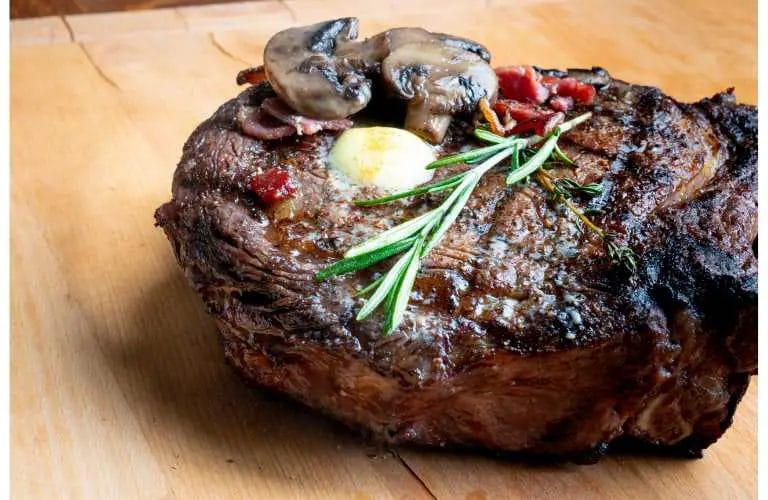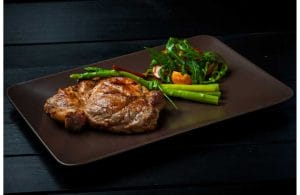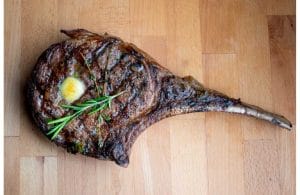If you’re wondering how long you can leave steak in sous vide, we’ve got you covered. Sous vide cooking is a popular technique that involves vacuum-sealing food and cooking it in a controlled water bath at a precise temperature.
When it comes to steak, the duration depends on the desired level of doneness and thickness of the cut. In general, a 1-inch thick steak can be cooked to medium-rare perfection in about 1-2 hours, while thicker cuts may require longer cooking times.
When using sous vide, there’s no need to worry about overcooking the steak. The low and steady cooking temperature ensures that the meat is evenly cooked throughout, resulting in a tender and juicy steak.
Plus, you can leave the steak in the sous vide machine for additional time without it becoming overcooked, making it a convenient option for busy cooks.
It’s important to note that while sous vide cooking offers precise control and guarantees consistent results, food safety should always be a priority.
To ensure the steak is safe to eat, it’s recommended to cook it at a temperature that is hot enough to pasteurize the meat. This is typically around 130°F (54.4°C) for medium-rare and higher for well-done steaks.
In conclusion, sous vide cooking allows you to achieve restaurant-quality steak at home with minimal effort. With the ability to cook the steak for a longer duration without fear of overcooking.
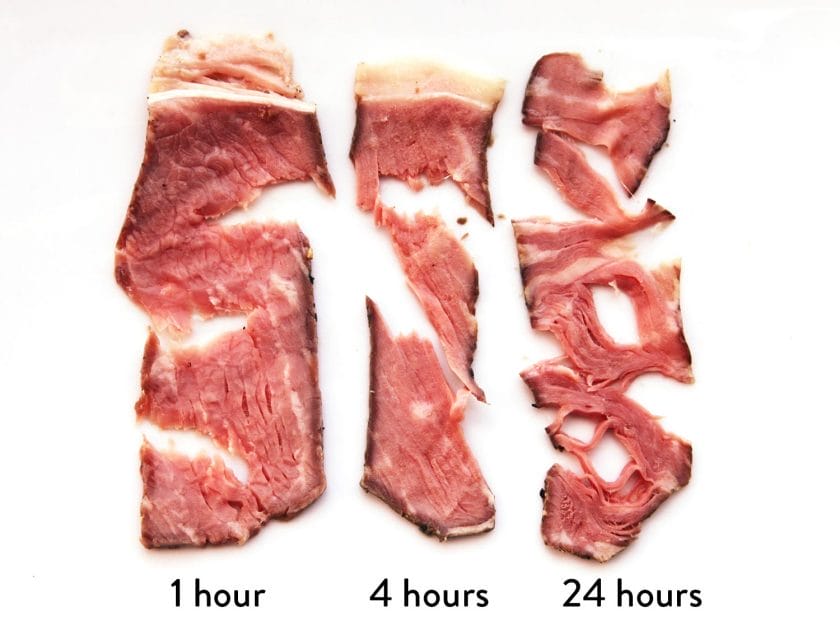
Perfectly Cooked Steak: The Ideal Sous Vide Time
When it comes to cooking steak, achieving the perfect level of doneness can be a challenge. One method that has gained popularity in recent years is sous vide cooking. Sous vide, which means “under vacuum” in French, involves cooking food in a precisely controlled water bath.
This technique allows for precise temperature control and evenly cooked meat. However, determining the ideal sous vide time for a perfectly cooked steak can be a bit tricky.
The Sous Vide Process
Before we dive into the ideal sous vide time for a steak, let’s briefly go over the sous vide process. To cook a steak sous vide, you’ll need a few key tools: a vacuum sealer, a sous vide immersion circulator, and a water bath. Here’s how it works:
- Season your steak with salt, pepper, and any other desired spices.
- Place the steak in a vacuum-sealed bag and remove as much air as possible before sealing.
- Preheat your water bath to the desired final temperature for your steak (we’ll discuss this in more detail later).
- Submerge the vacuum-sealed steak in the water bath and cook for the recommended sous vide time.
- Remove the steak from the bag and pat it dry with a paper towel.
- Sear the steak on a hot grill or in a cast-iron skillet to achieve a delicious crust.
- Let the steak rest for a few minutes before slicing and serving.
Determining Sous Vide Time
The ideal sous vide time for a steak depends on various factors, including the thickness of the steak, the desired level of doneness, and personal preference.
As a general rule of thumb, thicker steaks will require longer cooking times to achieve the desired doneness. Here’s a guide to help you determine the ideal sous vide time based on steak thickness:
| Steak Thickness | Sous Vide Time |
|---|---|
| 1 inch (2.5 cm) | 1-2 hours |
| 1.5 inches (3.8 cm) | 2-3 hours |
| 2 inches (5 cm) | 2.5-4 hours |
Keep in mind that these times are just a starting point. It’s crucial to monitor the internal temperature of the steak using a meat thermometer to ensure it reaches the desired level of doneness. The sous vide cooking process will keep the steak at a constant temperature, resulting in a perfectly cooked interior.
Final Temperature and Doneness
Aside from the cooking time, the final temperature also plays a significant role in determining the doneness of your steak. Here are the recommended final temperatures for different levels of doneness:
- Rare: 125°F (52°C)
- Medium Rare: 135°F (57°C)
- Medium: 145°F (63°C)
- Medium Well: 155°F (68°C)
- Well Done: 160°F (71°C)
It’s important to note that sous vide cooking may result in a steak that appears less seared compared to traditional cooking methods. To achieve that desired crust, it’s essential to sear the steak after the sous vide process.
This will give the steak a beautiful browned exterior, enhancing the overall flavor and presentation.
Achieving Ideal Texture: How Long to Sous Vide Steak
Sous vide cooking has gained popularity among home chefs and professional cooks alike for its ability to produce perfectly cooked and tender steaks. By cooking the steak in a temperature-controlled water bath, the meat is cooked evenly and retains its natural juices, resulting in a melt-in-your-mouth texture.
But the question remains: how long should you sous vide your steak to achieve the ideal texture? The answer depends on the thickness of your steak and the level of doneness you desire. Let’s explore the recommended cooking times for different steak thicknesses:
1. Thin Steaks (1 inch or less)
If you have a thin steak that is 1 inch or less in thickness, you can achieve a perfect medium-rare steak by cooking it for 1 to 1.5 hours at a temperature of 129°F (54°C). This will give the steak a nice pink center and a tender texture.
If you prefer your steak medium, you can increase the cooking time to 1.5 to 2 hours at a temperature of 140°F (60°C). This will result in a slightly firmer texture with a hint of pink in the center.
2. Medium Steaks (1 to 1.5 inches)
For medium steaks that are 1 to 1.5 inches thick, the recommended cooking time for a medium-rare steak is 2 to 3 hours at a temperature of 129°F (54°C). This longer cooking time allows the heat to penetrate the thicker cut of meat and achieve the desired level of doneness.
To cook a medium steak, you can increase the cooking time to 3 to 4 hours at a temperature of 140°F (60°C). This will result in a steak that is cooked through with a slightly pink center.
3. Thick Steaks (1.5 to 2 inches)
If you have a thick steak that measures 1.5 to 2 inches in thickness, it’s important to give it enough time to cook evenly and achieve a tender texture. For a medium-rare steak, the recommended cooking time is 3 to 4 hours at a temperature of 129°F (54°C).
To cook a thick steak to medium, you can increase the cooking time to 4 to 5 hours at a temperature of 140°F (60°C). This will ensure that the center of the steak is cooked to your desired level of doneness.
4. Very Thick Steaks (2 inches or more)
For very thick steaks that are 2 inches or more in thickness, a longer cooking time is required to achieve the ideal texture. To cook a medium-rare steak, you should sous vide it for 4 to 6 hours at a temperature of 129°F (54°C).
If you prefer your steak medium, you can increase the cooking time to 5 to 7 hours at a temperature of 140°F (60°C). This will ensure that the center of the steak is fully cooked and tender.
Sous Vide Times for Different Steak Cuts
When it comes to cooking steak, achieving the perfect level of doneness can be a challenge. Undercooking or overcooking can result in a less-than-ideal dining experience. However, with the advent of sous vide cooking, precision in cooking steak has become more attainable than ever before.
Sous vide, which means “under vacuum” in French, is a cooking technique that involves sealing the food in a bag and cooking it in a water bath at a precise temperature. This method allows for consistent and uniform cooking, ensuring that the steak is cooked to your desired level of doneness.
Each steak cut has its own unique characteristics and requires a specific cooking time to achieve the desired level of doneness. Here are the recommended sous vide cooking times for different steak cuts:
Ribeye Steak:
Ribeye steak is known for its rich marbling and tenderness. To achieve a medium-rare doneness, cook the ribeye steak at 130°F (54°C) for 2-4 hours. For a medium doneness, increase the cooking time to 4-6 hours.
Sirloin Steak:
Sirloin steak is a leaner cut of meat with less marbling. To achieve a medium-rare doneness, cook the sirloin steak at 130°F (54°C) for 1-2 hours. For a medium doneness, increase the cooking time to 2-4 hours.
Tenderloin/Filet Mignon:
Tenderloin, also known as filet mignon, is a highly prized and tender cut of meat. To achieve a medium-rare doneness, cook the tenderloin/filet mignon at 130°F (54°C) for 1-3 hours. For a medium doneness, increase the cooking time to 3-5 hours.
T-Bone/Porterhouse Steak:
T-Bone and Porterhouse steaks are a combination of tenderloin and strip loin, making them a versatile and flavorful cut of meat. To achieve a medium-rare doneness, cook the T-bone/Porterhouse steak at 130°F (54°C) for 2-4 hours. For a medium doneness, increase the cooking time to 4-6 hours.
New York Strip Steak:
New York strip steak is known for its bold and beefy flavor. To achieve a medium-rare doneness, cook the New York strip steak at 130°F (54°C) for 2-4 hours. For a medium doneness, increase the cooking time to 4-6 hours.
Flank Steak:
Flank steak is a thin and flavorful cut of meat. To achieve a medium-rare doneness, cook the flank steak at 130°F (54°C) for 2-4 hours. For a medium doneness, increase the cooking time to 4-6 hours.
Skirt Steak:
Skirt steak is a thin and fibrous cut of meat that is best suited for marinating and grilling. To achieve a medium-rare doneness, cook the skirt steak at 130°F (54°C) for 1-2 hours. For a medium doneness, increase the cooking time to 2-4 hours.
It’s important to note that these recommended cooking times are just a starting point. Depending on the thickness of the steak and personal preference, you may need to adjust the cooking time slightly.
Additionally, sous vide cooking provides the flexibility to hold the steak at the desired temperature for an extended period without overcooking, so you can have your steak cooked to perfection whenever you’re ready to enjoy it.
Sous Vide Steak: Tips for Achieving the Perfect Doneness
When it comes to cooking steak, achieving the perfect doneness can be a challenge. However, with the sous vide cooking method, you can easily achieve tender and juicy steaks every time.
Sous vide cooking involves vacuum-sealing the steak in a bag and cooking it in a temperature-controlled water bath. This precise cooking technique ensures that the steak is cooked to the desired level of doneness without overcooking or drying it out.
1. Start with Quality Meat: To achieve the best results, it’s important to start with high-quality steak. Look for cuts that are well-marbled with fat, as this will contribute to the tenderness and flavor of the final product.
2. Seasoning: Before vacuum-sealing the steak, season it generously with salt and pepper. You can also add other spices or herbs to enhance the flavor. The seasoning will penetrate the meat during the cooking process and add depth to the final dish.
3. Vacuum-Sealing: Place the seasoned steak in a vacuum-sealable bag and remove as much air as possible before sealing. This will ensure that the steak cooks evenly and retains its natural juices.
4. Preheating the Water Bath: Fill a large container or a sous vide machine with water and set the temperature according to the desired doneness. For example, if you prefer a medium-rare steak, set the temperature to 130°F (54°C).
5. Cooking Time: The cooking time will vary depending on the thickness of the steak and the desired doneness. As a general rule, a 1-inch thick steak will take about 1-2 hours to reach medium-rare. However, it’s always recommended to consult sous vide cooking charts or recipes for more precise cooking times.
6. Finishing the Steak: Once the steak is cooked to the desired doneness, remove it from the bag and pat it dry with paper towels. Preheat a skillet or grill to high heat and sear the steak for a few seconds on each side to create a flavorful crust. This step will also enhance the visual appeal of the steak.
7. Resting: Allow the steak to rest for a few minutes before slicing and serving. This will help redistribute the juices and ensure a tender and juicy steak.
8. Serving Suggestions: Sous vide steaks pair well with a variety of side dishes and sauces. You can serve them with mashed potatoes, roasted vegetables, or a tangy chimichurri sauce for a burst of flavor.
Beyond the Basics: Experimenting with Sous Vide Steak Times
Now that you have mastered the basics of sous vide cooking and are comfortable cooking a perfect steak every time, it’s time to take your skills to the next level.
Experimenting with sous vide steak times can elevate your steak game and allow you to achieve different levels of doneness and textures. In this section, we will explore the impact of varying cooking times on the final outcome of your steak.
1. Understanding the Basics:
Before diving into experimentation, it’s important to have a solid understanding of the basic sous vide cooking principles. Sous vide involves cooking food in a temperature-controlled water bath for an extended period of time.
The precise temperature control ensures that the food is cooked evenly throughout while preserving its natural juices and flavors. This technique is especially popular for cooking steaks, as it allows for precise control over the level of doneness.
2. Factors Affecting Cooking Time:
When experimenting with sous vide steak times, there are several factors that can influence the cooking time:
- The thickness of the steak: Thicker steaks will require longer cooking times to reach the desired level of doneness.
- The desired level of doneness: Different levels of doneness, such as rare, medium-rare, and well-done, will require varying cooking times.
- The cut of steak: Different cuts of steak have varying levels of tenderness, which can affect the cooking time.
3. The Impact of Cooking Time:
Varying the cooking time can have a significant impact on the texture and doneness of your steak. Here are some general guidelines to keep in mind:
- Shorter cooking times (1-2 hours): This will result in a steak that is more rare or medium-rare. The texture will be tender with a slight pink center.
- Medium cooking times (2-4 hours): This will yield a medium level of doneness. The steak will be pink and juicy throughout.
- Longer cooking times (4-6 hours or more): This will result in a steak that is well-done. The texture will be more firm and the steak will be cooked all the way through.
4. Conducting Your Experiment:
To experiment with sous vide steak times, start by selecting steaks of the same thickness and cut. Divide them into separate vacuum-sealed bags and season each steak with your desired marinade or seasonings.
Then, set up your sous vide cooker and preheat the water bath to the desired temperature based on your desired level of doneness.
Next, place each steak bag into the water bath for different lengths of time. Keep track of the cooking time for each steak using a timer or the sous vide cooker’s timer function.
Once the cooking time is complete, remove the steaks from the water bath and pat them dry. Optionally, you can sear the steaks on a hot grill or cast-iron skillet to develop a flavorful crust.
5. Analyzing the Results:
Once your steaks are cooked and seared, it’s time to analyze the results. Pay attention to the texture and doneness of each steak. Note any differences in tenderness, juiciness, and overall flavor. This will help you determine your preferred cooking time for achieving the desired steak doneness.
6. Fine-Tuning Your Technique:
Based on your experimentation and analysis of the results, you can now fine-tune your sous vide steak cooking technique. Adjust the cooking time based on your preferences and the factors mentioned earlier, such as the thickness of the steak and the desired level of doneness.
Keep experimenting and taking notes until you find your perfect sous vide steak cooking time.
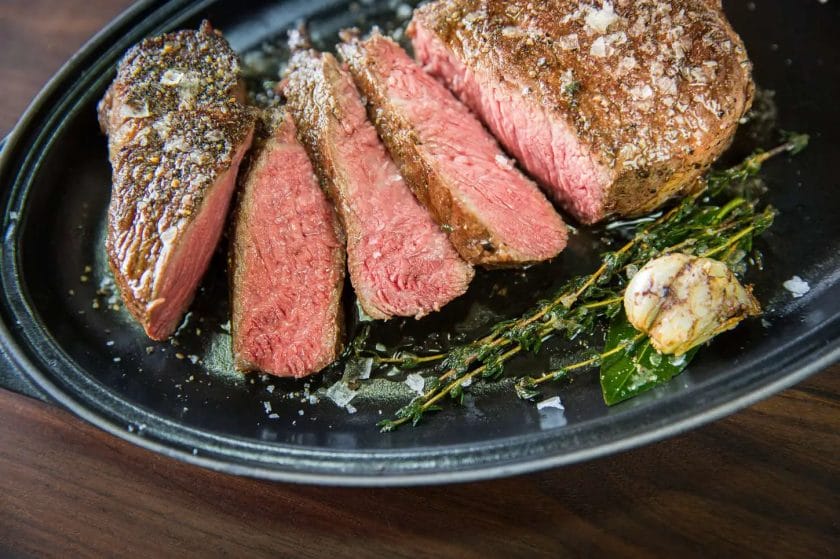
FAQs
How long can you leave steak in sous vide?
You can leave steak in sous vide for several hours without any negative effects.
The recommended cooking time for a medium-rare steak is usually around 1-2 hours, but you can safely leave it in the sous vide bath for up to 4 hours without overcooking. This allows for a consistent and perfectly cooked steak every time.
Conclusion
In conclusion, the sous vide cooking method has revolutionized the way we prepare steak. By sealing the steak in an airtight bag and cooking it at a precise temperature for an extended period, the result is a perfectly cooked piece of meat that is tender and juicy.
When it comes to the question of how long you can leave steak in sous vide, the answer depends on various factors such as the thickness of the steak and your desired level of doneness. Generally, most steaks can be cooked for anywhere between 1 to 4 hours.
Longer cooking times can result in even more tender meat, but it’s important to avoid cooking the steak for too long as it can become overly soft and lose its texture.
It is recommended to use a reliable sous vide recipe or cooking guide to determine the ideal cooking time for your specific cut of steak. So go ahead, experiment with different cooking times, and enjoy the perfectly cooked steak every time!

